


While The Big Sleep is universally acknowledged as one of the great film noire detective movies, it is also criticized as having such a convoluted plot that it's almost impossible to follow. For me, the confusion about who did what to whom made it even more enjoyable because it retained its mystery even after watching the film several times. It was one movie I could count on to disclose something new every time it was seen. It took five viewings for me to nail down all the intricacies of the plot. After that, watching remained enjoyable because I still appreciated all that went into developing this understanding. Besides, who can resist the saucy dialog between the two leading stars: Humphrey Bogart and Lauren Bacall?
Then my wife gave me a DVD of the movie that had both the 1946 version that was released and an earlier 1944 version that was never shown, except in a few overseas venues. Comparing these two versions renewed my interest in the movie as did the outstanding commentary on the film's history. This motivated me to create this page to honor this great movie in the hopes that it might tempt people who have never seen it to give The Big Sleep a try. The page contains an extensive cast list with images of the actors, many screen shots of the picture's most classic scenes, comments on how the film captures aspects of the time in which it was made, an explanation of the plot (warning: contains spoilers) and much more. I hope you'll enjoy it.
A
Brief History:
The Big Sleep, the title of which refers to death, was based on Raymond Chandler's first and immensely popular 1939 hard-boiled detective novel of the same title. Filming the movie version began on October 10, 1944 and concluded January 12, 1945 with a planned release date in March, 1945. However, Warner Brothers had several war movies they felt had to be released before World War II ended so The Big Sleep was shelved until 1946. During this time, the studio decided to reshoot several scenes, add new scenes and cut others. The motivation was that because Lauren Bacall's performance in her second film, Confidential Agent, received so many negative reviews new footage was needed to highlight her strengths. This "improved" version was finally released August 31, 1946. The earlier version remained lost for many decades until it was rediscovered.
The
Plot: (Warning:
spoilers follow)
Philip Marlowe, played by Humphrey Bogart, is hired by wealthy General Sternwood to get rid of a man named Geiger who is attempting to blackmail him for what at first appears to be Sternwood's younger daughter's, Carmen, gambling debts. Marlowe quickly discovers two other mysteries plague the Sternwoods: what happened to the General's companion Sean Regan and what hold a gangster named Eddie Mars has over the family. Intrigue increases rapidly as first Geiger, then the Sternwood's chauffeur, Owen Taylor, then Joe Brody (a hood taking over Geiger's underworld business) are murdered. As Marlowe struggles to figure out who's killing who, he develops a sometimes adversarial relationship with Vivian Sternwood, General Sternwoods older daughter, played by Lauren Bacall. Marlowe and Vivian's saucy exchanges are one of the most entertaining features of The Big Sleep.
By the end of the movie the viewer discovers that the plot actually began before the opening scene. Carmen, a mentally unstable drug user and nymphomaniac, killed Regan because she loved him and he rejected her. Although it's never verified, his rejection may have been because he was interested in Eddie Mars' wife. Eddie Mars knew about the murder and held it over Vivian, who gambled at his casino.
Arthur Geiger's hold over the Sternwoods was that Carmen got her drugs from him and disguised the payments as gambling debts. Geiger decided to up the anty by taking nude pictures of her at his house while she was in a drugged stupor. Owen Taylor, the Sternwood's chauffeur, loved Carmen so he shot Geiger and took the photos to protect her. Joe Brody then killed Taylor to get the photos so he could use them to blackmail the Sternwoods. While Marlowe is confronting Brody with these facts, Brody is killed by Carol Lundgren, Geiger's chauffeur and homosexual lover, because he mistakenly thinks Brody killed Geiger.
While all this is going on Eddie Mars is keeping his wife hidden away to encourage people to think that Regan had run off with her. If it was known she hadn't, then Regan's murder might be uncovered and Mars' hold over the Sternwoods broken.
As Marlowe's figuring all this out he's approached by Harry Jones, a low-level hood and boy friend to Agnes Lowzier, Joy Brody's accomplice, to tell him that in exchange for $200 she'd tell Marlowe where Mars had hidden his wife. Before Marlowe meets with Agnes, Harry is murdered by one of Mars' thugs.
Agnes tells Marlowe where to find Mars' wife. He goes to question her and is captured by Lash Canino, the same man who killed Harry Jones. Vivian helps Marlowe escape and he eventually kills Canino. Marlowe and Vivian head back to Geiger's house to set up a trap for Eddie Mars, during which all remaining questions are resolved and Mars is accidentally killed by his own men. Marlowe concocts a story that'll protect Carmen from the police after getting a promise from Vivian to institutionalize her. Although not implicitly stated, the ending strongly suggests that Vivian and Marlowe end up together.
Scene
Changes and
Screen Shots of Key Scenes:
The first significant changes occur about 25 minutes into the movie. Marlowe follows Geiger to his house. Carmen shows up and some time later Marlowe sees a flash and hears two shots. He breaks in to discover Geiger dead, Carmen in a drugged stupor and film missing from a concealed camera facing her. Scenes of him searching the house and washing the glass she drank drugs from were cut from the 1946 version. Instead the action jumps from him laying Carmen on a couch to his discovering a blackmail book in Geiger's desk. I assume the cuts were made to keep the duration of the movie to under two hours. Another reason is that during the search, Marlowe's action of sniffing a perfumed handkerchief
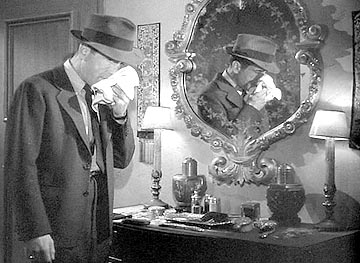
hint at Geiger's homosexual tendencies, a topic considered too risque for the 1940s. (Homosexuals in the 1940s were considered the lowest of social outcasts. The vast majority carefully guarded their secret. If one was found out they were shunned by the rest of society. Pornography and those who purchased it were equally considered disgusting.) These cuts weaken the 1946 version because without the scenes we don't know why Carol Lundgren wanted to avenge Geiger's death. The cuts also prevent the audience from seeing Marlowe's discovery of the kitchen window, which was broken by Joe Brody to get in, learn about the pictures of Carmen and the fact that someone had killed Geiger to get them.
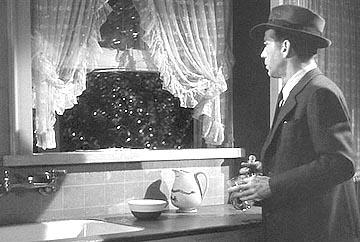
Shortly after this there's a very brief shot of Marlowe driving Carmen home. His expression of disgust says a lot about what he thinks of her. This scene was cut from the 1946 version.
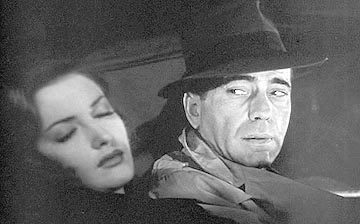
The scene where he drops her off was also changed. In the original he only handed Carmen over to Norris, the butler. In the improved version a scene was added with Marlowe carrying Carmen into Vivian's bedroom. This allowed them the opportunity for a few suggestive exchanges.
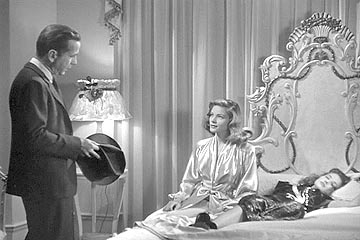
Because
of this scene change, some of the dialog of her visiting him in his
office the next day no longer made sense. The studio corrected this
with Lauren voicing over what she said in the original version.
Sharp-eyed viewers can just pick out where her lip motions aren't
synchronized with what she's saying.
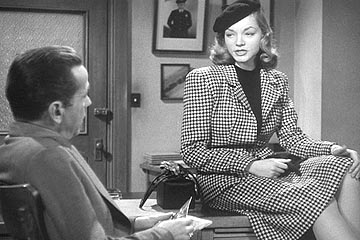
This scene also contains one of the funniest segments in the movie as they take turns torturing a police desk sergeant over the phone.
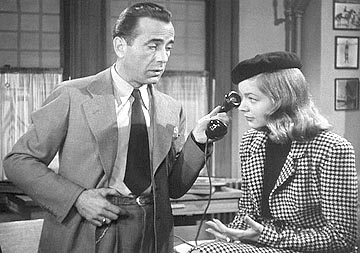
A
cute bit took place early in the movie when Eddie Mars confronts
Marlowe in Geiger's house. After finding the blood stain from Geiger,
Mars nonchalantly pulls out a gun, shows it to Marlowe and asks,
"Do you mind?"

To which Marlowe equally nonchalantly shrugs it off saying, "No. I'm used to it."
One
of the biggest improvements was exchanging the so-called
"veil" scene in his office where Vivian tries to pay him
off to drop the case
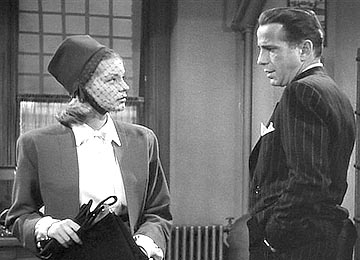
to one where they meet in a restaurant and trade innuendo-ladened comments.

The biggest mistake in the 1946 version of The Big Sleep was removing the scene in a car where Marlowe and police inspector Bernie Ohls take Carol Lundgren in and discuss how to handle the district attorney...
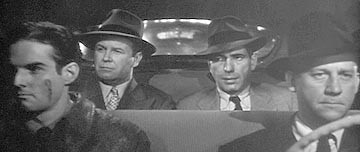
... and even more importantly the subsequent meeting with the District Attorney...
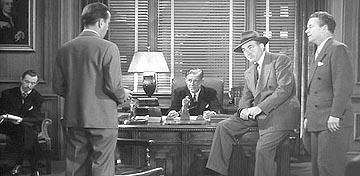
...during which many of the loose ends in the case are tied up. This 8-minute scene is critical for understanding the plot.
The closing
scene was shot very interestingly. After the dialog had ended Vivian
and Marlowe look at each other acknowledging their love.
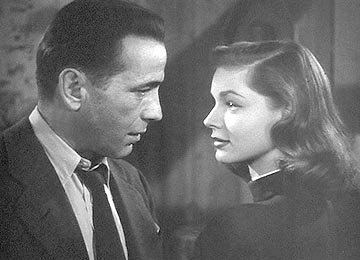
Then you can hear to sound of the approaching police sirens. As they look in the direction of the sirens their expressions turn apprehensive because they are looking into an uncertain future of lying to the police and taking care of the homicidal Carmen
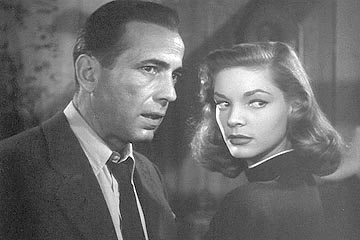
Then they look back at each other confident that their love will surmount any difficulties.

Fun
Trivia, Bloopers
and Interesting Tidbits:
Right before Eddie Mars' thug attempts to rob Vivian outside the casino, Marlowe arms himself with a gun taken from a gun holder hidden under the dashboard of his car.

Note that he's taking the smaller gun in the lower left. One would assume that if he kept a gun on him through the rest of the movie it would be this one. Towards the end of the movie, after Vivian helped him escape from Canino, he goes to the same secret compartment to get the remaining gun.
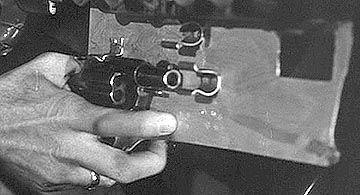
Oddly, the larger gun in the upper right is now missing and the smaller gun has returned to the lower left position.
Scene
backgrounds can sometimes disclose interesting facts about the times
in which a movie was made. Consider the sign on the wall of a diner
Marlowe briefly visited:
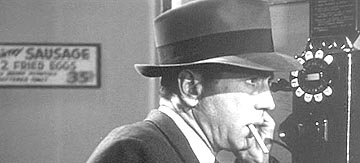
At first glance it provides an idea of the cost of a sausage and egg breakfast back in 1944. Thirty-five cents may seem like a good deal for so long ago but after correcting for inflation that's the equivalent of $6.00 in 2013, little steep for a modest breakfast from a small diner. The reason may have been that during the war egg and meat products were scarce and therefore proportionately more expensive.
A second interesting tidbit comes from the telephone operator, who states that his call to Eddie Mars' casino will cost 55 cents for the first three minutes. This indicates that it was a long distance call to somewhere outside of Los Angeles and that back then long distance calls were very expensive. The 55-cent call equates to $8.00 in 2013... and that's only for the first three minutes to a location less than 60 miles away.
Look close at
the lower left corner of the front window of Marlowe's car and you'll
spot three stickers.
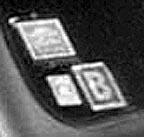
The one that can be made out as "B" was a gas rationing sticker. Most people got an "A" sticker that was only good for 3 gallons of gas. People who used their vehicles as part of their job, such as Marlowe, could get a "B" sticker which allowed them more. "C" stickers, reserved for trucking and defense work, allowed owners to fill the tank. Prior to the war, gas sold for an average of $.13 a gallon, equivalent to $2.34 in 2013. During the war the price increased to $.18 or $2.99 in 2013. Considering the demands placed on petroleum by the war effort, this increase is not as great as one would expect. The reason is that gas was rationed, a process which blunted the effect of supply and demand.
I sent images
of the cars the major players drove to my father-in-law, who grew up
on the 30s and 40s, and asked him for his best guesses as to what
they were. Here are his responses:

Philip Marlowe's car, shown above, was probably a late 1930s Chrysler or Dodge.
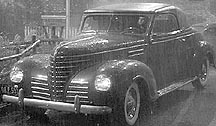
Carmen's was newer, a 1940 or 1941 Plymouth convertible.
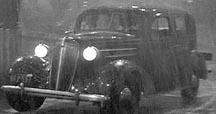
Geiger's car was probably a 1938 or 39 Chevy.

He wasn't able to identify Brody's woody station wagon because the picture didn't supply enough detail.
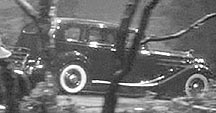
Owen Taylor drove the Sternwood limousine, a late model Packard. Later he would be found dead in this car.
Because the movie is in black and white, most people watching it will get the impression that all the cars in 1938 were either black or gray. While the vast majority of cars in this era were indeed black; cars in brown, yellow, red and green were also available. High end luxury cars could be special ordered in a few other hues.
The Sternwood's, being very rich, might be expected to drive brand new 1944 or 1945 cars. That fact is that after America entered World War II late in 1941 there were no new models release until 1946.
So how rich
were the Sternwoods? In Chandler's novel they were reported to be
worth $4,000,000, the equivalent of around $70 million in 2013 dollars.
Other interesting monetary issues are that that Marlowe's $25 a day fee would be $380 a day in 2013 and the $200 Agnes wanted for telling Marlowe where to find Eddie Mars' wife would be worth over $3,000. Finally, the $500 Vivian gave Marlowe to pay him off would be $8,000. All totaled that comes to $8,240... not bad for two day's work. Of course if Marlowe ends up marrying the very wealthy Vivian Sternwood he won't have to worry about money any more.
After Marlowe
captures Carol Lundgren, he calls Bernie Ohls and opens the
conversation by asking him how he's fixed for "red points."
Red points were rationing coupons for meat and sugar, very valuable
in wartime America. They became synonymous with how someone stood in
the eyes of his or her boss, similar to today's "brownie
points," though without the negative connotation.
Listen carefully to this bit if telephone dialog and you can pick up a couple of interesting tidbits. First, Bernie's response to Marlowe's red-points question is "no," to which Marlowe responds, "who has?" meaning that in 1944 meat was in short supply. Second, the short interplay adds appropriate context to Marlowe's later reference to Lundgren laying tied up on the floor at his feet as being, "cold meat laid out for you," reflecting back to his initial inquiry about red points.
While I like
Lauren Bacall, I have to confess that I'm not a fan of her singing so
I wonder why her song Her Tears
Flowed Like Wine was included.
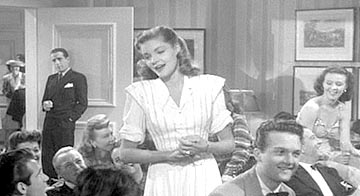
The only reason I can imagine is that it allowed a bit of non-verbal comical exchange between Vivian and Marlowe.
There is a
picture Roosevelt on the wall of the Acme bookstore behind Marlowe as
he enters.
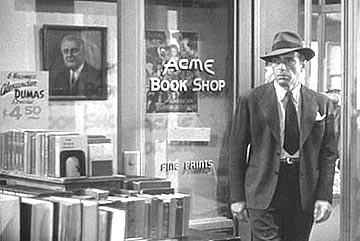
I read one review that claimed this proved that this scene was shot in 1944 before Roosevelt's death. This may be the case but I don't accept the picture as proof because the owner may have chosen to leave it up in remembrance or out of respect. What is more interesting is that this portrait reflects a time when the president was so honored that people commonly displayed such pictures. How often do you see pictures of the current president on display today?
The studio
decided to refilm the scene outside Mars' casino where Vivian is held
up and Marlowe saves her. Over a year had pasted and, more
importantly, Bogart and Bacall had gotten married. Comparing pictures
of her from both shoots, it appears to me that she looks much more
mature in the 1946 version.
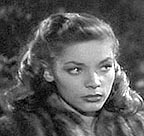
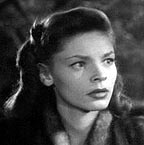
.......1944......................1946....
There are also slight differences in her hair and fur coat, though that may be the result of lighting changes.
The scene
where Vivian visits Marlowe in his office to discuss the blackmail
problem has an interesting bit where she's rubbing her knee through
her skirt. Marlowe tells her go ahead and scratch, which she does.

I've often wondered if her aversion to scratching was from her not wanting to show him her knee or from the culture of the times that considered it improper for a woman to scratch, as if it suggested she had lice or a disease of some sort. I checked with my father-in-law about this and he said there was no stigma with a lady discretely scratching an itch.
Soon after
Marlowe discovers Carmen in Geiger's house, he picks up and sniffs
the contents of a glass from which she had been drinking.
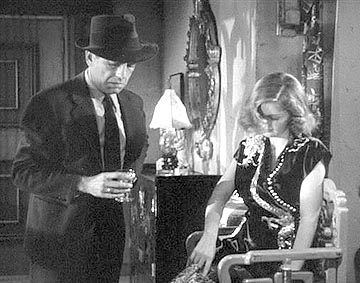
The disgusted look on his face suggests it wasn't lemonade. Although the movie doesn't clarify what it was, the book does: a mixture of ether and laudanum. Laudanum is opium dissolved in alcohol.
Today smoking
is rarely seen in movies or on television but back in the 1940s it
was so common that's it's hard to appreciate now. In The Big
Sleep, not only did many characters smoke but the very first
opening image

and the film's last image
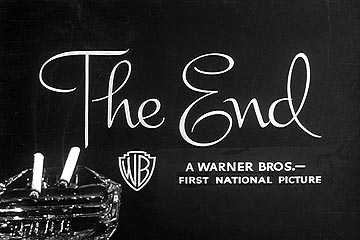
feature cigarettes. Statistics indicate that one-half of the entire US population smoked in the 1940s.
Cast
List:
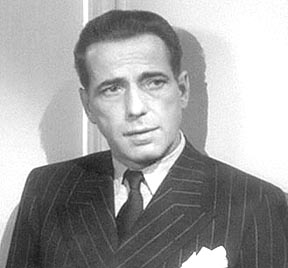
Philip
Marlowe, played by Humphrey Bogart, one of the greatest screen
presences of all time. Born in 1899, he would have been 45 when
filming started and 47 by the time the film was released in 1946.
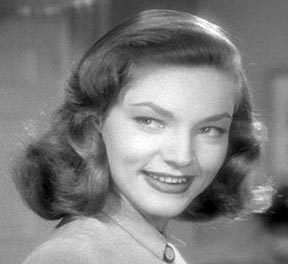
Vivian
Sternwood, played by Lauren Bacall. Born in 1924, she was just 20
when filming began, a quarter of a century younger than Bogart, whom
she would marry before the film's 1946 release. In a way, this film
captures Bogart and Bacall falling in love in real life right in
front of the camera.
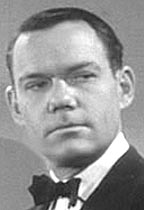
Eddie Mars,
played by John Ridgely. Ridgley was a successful supporting actor who
made scores of movies, usually in more likable roles.

Carmen
Sternwood, played by Martha Vickers. She was 19 in the movie and at
one time married to Mickey Rooney. Although there were signs she
might become a star her career never took off. This outfit would have
been considered too risque for a lady to wear in public in the early
1940s. As such it would have given a hint to the audiences back then
that Carmen lived on the wild side.

Acme Book
Store proprietress, played by Dorothy Malone. Warner Brothers was
pushing her career and her short piece in the movie was heavily
worked to make the most of it. One of the things that was done was to
have her turn from a bookworm
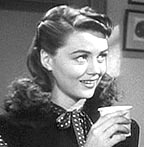
to a more attractive woman by removing her glasses and loosening her hair. She was 19 here and would go on to become a mainline star.
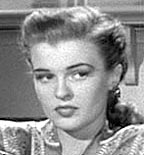
Mona Mars,
played by Peggy Knudsen in the 1946 version.

The original
1944 Mona Mars, played by Pat Clark. I suspect she was replaced
because her angular face slightly resembled Lauren Bacall's.
Switching to the more rounded, softer-faced Peggy Knudsen helped
Bacall stand out.
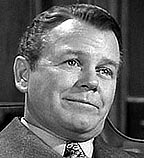
Bernie Ohls,
played by Regis Toomey. He was the chief inspector in the district
attorney's office. Toomey was an immensely popular supporting actor
who starred in over 150 movies.

General
Sternwood, played by Charles Waldron.
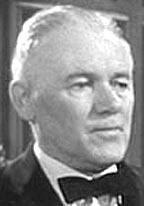
Norris,
General Sternwood's butler, played by Charles D. Brown. Mostly a
stage performer in supporting roles, Brown also made over two dozen
movies, usually as stalwart, dependable characters.
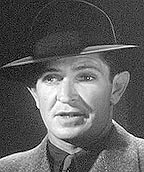
Lash Canino,
Eddie Mars' number one hood, played by Bob Steele. All though this is
a minor part, after seeing the film several times I became impressed
with how well it was done. Canino is portrayed as being truly evil,
yet the actor never crosses over into being too sarcastic, twisted or
melodramatic. Very successful at playing two-fisted characters in
spite of his small size, he starred in over 150 films and in scores
of TV episodes.
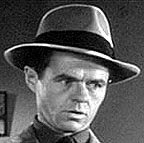
Harry Jones,
played by Elisha Cook Jr. Often cast as a hood in spite of his small
size. Cook has been on stage, screen and TV for over sixty years. He
often starred in the Magnum, P.I. series as Icepick.
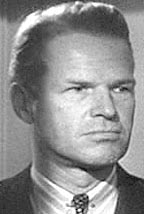
Joe Brody,
played by Louis Jean Heydt. The first few times I saw The Big Sleep I
kept mixing up Brody with Mars because their size, shape and facial
characteristics are so similar. I think the casting office would have
done better to find two villains that didn't look so much alike.
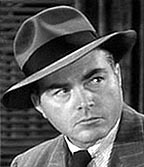
Captain
Cronjager of the DA's office, played by James Flavin. He was only
seen in the DA office meeting with the DA, Ohls and Marlowe, which
was removed in the 1946 version. Flavin starred in dozens of films in
supporting roles and had literally hundreds of TV appearances,
typically playing tough cops or military sergeants. In real life he
was a West Point graduate.
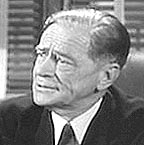
District
Attorney White, played by Thomas E. Jackson. His scene was cut.
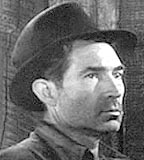
Art Huck,
played by Trevor Bardette. Art ran a garage east of Realito that
fronted the house where Eddie Mars' wife was hiding.
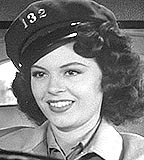
Taxi driver,
played by Joy Barlow.
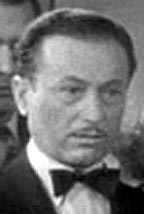
The croupier
at Eddie Mars' casino, played by Jack Chefe.

Medical
examiner at Lido Pier, played by Joseph Crehan.

Agnes Lowzier,
the saleslady at Geiger's bookstore and Joe Brody's accomplice,
played by Sonia Darrin. Although her face is very familiar it's
difficult to find information on her. She's appeared in only seven
films, all but one of which were uncredited. It's odd she was
uncredited in The Big Sleep because she had as much screen
time and dialog as Carmen.
Mystery Solved!
In 2016 Ms. Alice Griffin very kindly contacted me to provide a link to an article with an interview with Sonia Darrin explaining why she didn't receive screen credits. After filming but before the first release, Ms. Darrin's agent got into a violent argument with studio head Jack Warner. As a consequence, Mr. Warner declared he would never hire anyone connected with the agent and had Ms. Darrin's name stricken from the screen credits. He might have gone as far as cutting her from the movie altogether, but her scenes were too important to do so. Ms. Darrin's career never took off after that and she moved to New York, where she was successful as a top model. I'd like to express my profound appreciation to Alice Griffin for resolving this mystery. (Thanks, Alice!)
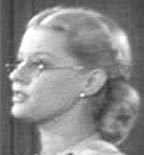
Librarian,
played by Carole Douglas.
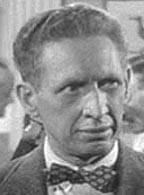
Sidney, one of
a pair of Eddies Mars' hoods used for comic relieve, played by Tom
Fadden. He was company for Pete.
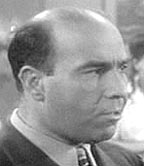
Pete, played
by Ben Walden, the real muscle in the pair of hoods always close to
Eddies Mars.
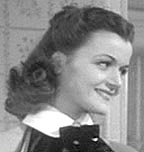
Cigarette girl
in Eddie Mars' casino, played by Shelby Payne.
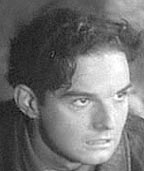
Carol
Lundgren, played by Tommy Rafferty. This was Geiger's chauffeur and
lover. He was the one that hid Geiger's body at first, then placed it
in repose with candles and eventually shot Joe Brody because he
thought Joe had killed Geiger.
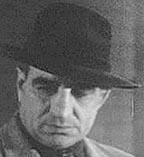
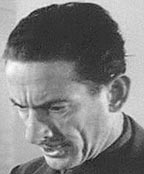
These are two
of Eddies Mars' thugs who beat up Marlowe to dissuade him from
investigating. They are played by Jack Perry and either Wally Walker
or Paul Weber. I wasn't able to determine which actor played which role.
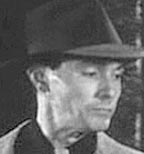
Still another
Eddie Mars thug, again either Wally Walker or Paul Weber. This is the
guy who staged a fake hold-up of Vivian outside the casino.
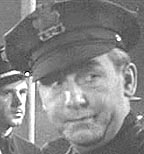
Ed, played by
Emmett Vogan. He was the deputy sheriff at Lido Pier.

Arthur Gwynn
Geiger, played by Theodore von Eltz. He ran a collectable book store
as a front for his printed pornography business. He was also
blackmailing the Sternwoods. It's unclear even after many viewings as
to what his connection was to Eddie Mars. Mars seems to have known
what was going on but I haven't yet figured out if he was Geiger's
boss or partner. Geiger is the one who took a nude photo of Carmen
Sternwood and was killed by the Sternwood chauffeur, Owen Taylor, to
protect her.
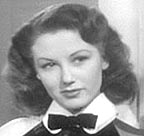
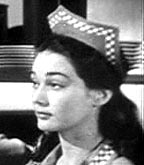
The first girl
was a hostess or waitress in Eddie Mars' casino, the second was a
waitress at a diner Marlowe visited briefly. They were played by
Deannie Best and Tanis Chandler, but I couldn't learn which played
what role.
Sadly, of all
these stars and the many extras in The Big Sleep only Lauren
Bacall is still alive.
Philip
Marlowe's Los Angeles:
Mention Los Angeles today and most people don't visualize the city itself but the enormous megalopolis that extends unbroken from the ocean to 100 miles east and 150 miles north and south from Santa Barbara to San Diego. All the cities surrounding LA have expanded to their limits until they butt up against each other in a solid mass of houses, apartments and businesses. That was not the Los Angeles of Philip Marlowe.
In 1938, all the towns surrounding LA were individual and distinct, most separated from their neighbors by stretches of undeveloped land. Dirt roads were common in many of the towns. Farms filled most of the area east of Pasadena, south of Ingelwood, west of Beverly Hills and north of North Hollywood. The San Fernando Valley in the north consisted mostly of unpaved roads. There were no freeways. The major street to the east was Foothill Boulevard, which is why it's described as the road driven by Mona Mars to her hiding place instead of the 210 or 10 freeways available today.
Los Angeles itself was markedly different from the high-rise metropolis that exists now. In 1938 tall buildings were few and far between. The original VA medical center was only three stories tall and could be seen for miles. A very few, widely spaced six-story buildings existed and could be seen anywhere in the valley. Even established cities like LA and Hollywood had open lots waiting development.
The population of LA county in Marlowe's 1938 was only 2.7 million, one-fifth of today's 10.6 million. Imagine four out of every five people suddenly disappearing from wherever you live and you get an idea of what it would have been like. Just as important was the rate of growth. In the 1930s the population in the Los Angeles area grew at the sleepy rate of 10,000 people per year. Once the war era started that exploded to over 100,000 per year, ten times the previous rate. This suggests an enormous increase in the pace of life.
Although The Big Sleep is usually described as taking place in Los Angeles, in fact most of the people lived and worked northeast of LA in Hollywood. Although the movie provided very little information on locations, Chandler's novel did. The following maps provide most of the important locations based on information from both the movie and the book:

(1) Marlowe lived in the Hobart Arms apartment near the intersection of Franklin and Kenmore.
(2) Geiger's illicit bookstore was on the north side of Hollywood Boulevard near Las Palmas.
(3) Geiger's house, rented to him by Eddie Mars, was on Laverne Terrace, a side street off Laurel Canyon Boulevard. I couldn't find Laverne Terrace, but it was described as being half way up the grade on Laurel Canyon, which is approximately where the 3 was placed.
(4) The Sternwood estate has the address 3765 Alta Brea Crescent in West Hollywood. No map I checked listed this street. But in the book it states that after dropping Carmen off at the estate Marlowe walked briskly for half an hour to get back to his car at Geiger's house. Assuming a good walker could do 4 miles per hour over hilly sidewalks in the rain, that places the Sternwood estate 2 miles from Geiger's house. Additional hints come from Marlowe's comment that he went down Laurel to get to the Sternwood's. An earlier description of their estate mentioned the rear of the house faced hills. This, combined with the fact that it was in West Hollywood, strongly suggests the Sternwood estate was located back in the hills northwest of Sunset Boulevard, just past Sweetzer Avenue.
(5) Brody's apartment is the Randall Arms at the corner of Brittany Place and Randall Place. Unfortunately, neither of these streets are listed on any map I have. However, Marlowe's description of following Brody there is good enough to make a guess as to its location. Marlowe states that he followed Brody east on Franklin Boulevard past Vine and Western, then turned north onto Brittany Place for 2 blocks. He doesn't mention going past Vermont while on Franklin, which puts a limit on how far east he went. Combining all this information suggests Brittany Place was close to Edgemount Avenue. Two blocks up is where I placed the 5 to mark Brody's apartment. Interestingly, Brody and Marlowe were almost neighbors.
(9) Harry Jones met his death at the hands of Lash Canino in Puss Walgreen's insurance office in the Fulwider Building at the corner of Santa Monica and Western Boulevard.
The
remaining locations are outside Hollywood so a map covering a larger
area is required.
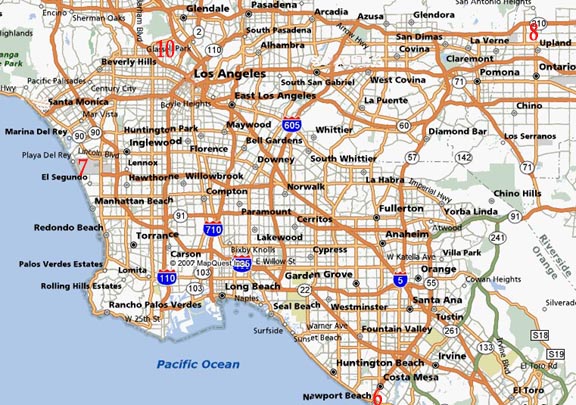
(10) Marks the location of the previous map. The following locations are speculative because I couldn't find listings for the towns stated as being where they were supposed to be.
(6) Hard searching turned up a couple of references to Lido Pier being located in the Newport Beach area. (This seems like an awfully long way for Joe Brody to have followed Owen Taylor before finally running him to ground and killing him, particularly since there weren't any freeways at the time.)
(7) Eddie Mars' gambling house, The Cypress Club, is stated as being located in Las Olindas, which again is not listed in LA or California maps. However, Marlowe describes it as being near the beach and driving along the coast through Del Rey after leaving it. Additionally, based on events preceding his driving there and the fact he arrived around 9 PM it's safe to assume that it's within two hours of Hollywood. Assuming his drive along the shore after leaving the club was in the direction he'd take on his way home and that "Del Rey" was short for the Playa Del Rey or Marina Del Rey, then a good guess for the club's location was just north of El Segundo.
According to my father-in-law, undercover gambling houses were common in the 1940s.
(8)
Mars' hideout, where his wife was
staying, was described as being east of Realito. Again, I couldn't
find a Realito. Checking through Chandler's novel I discovered that
the hiding place was described as being 40 miles east of Los Angeles.
Agnes states that she and Brody followed Mona Mars there along
Foothill Boulevard well past Pasadena. She also states that the house
was up a road that ran toward the mountains, which would be north.
Combining the distance from LA and the trip on Foothill suggests the
house was located north of Laverne or possibly Upland. In 1938 this
would have been beyond the Orange orchards that back then started
just east of Pasadena.
An
Interesting Experiment:
As an experiment, I set up the 1944 version in one DVD player and the 1946 version in another. both of which were connected to my TV. By skipping back and forth I was able to watch a version of The Big Sleep with all the best scenes from both movies. What resulted was a version of The Big Sleep that's 22 minutes longer than the original versions and many times better than either. The scenes that were added were Marlowe's search of the Geiger house, Marlowe driving Carmen home, Marlowe and Bernie Ohls driving Carol Lundgren to police headquarters and the big meeting in the DA's office. These scenes made it easier to understand the plot and the motivations of the characters. I wish someone would figure out how to convince whoever owns the rights to this movie to release a special extended version of it with these scenes included.
Links:
http://www.reelclassics.com/Movies/BigSleep/bigsleep.htm features an excellect history and plot synopsis.
http://www.filmsite.org/bigs.html has a history of the movie's creation and almost the entire dialog for the movie with scene descriptions. An outstanding resource for investigating the minutia of this film.
http://www.eskimo.com/~noire/ftitles/bigsleep/index.shtml has a nice set of screen shots.
A
Special Acknowledgement:
I wish to express my gratitude to my father-in-law, Mr. Dana R. Patten for providing an enormous amount of material for this page. He grew up in Chandler's Los Angeles of the 1930s and 40s and the background he supplied was indispensable. Thanks, Dana!